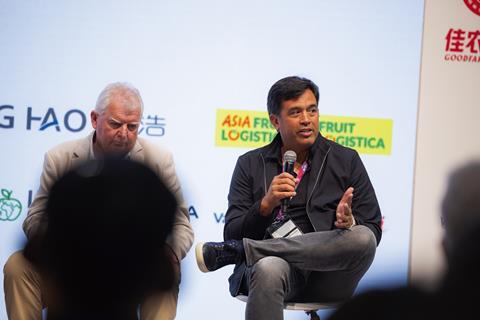Rapid growth in Chinese consumption, Asia’s in-market production and a move beyond blueberries were some of the key themes from Asiafruit Congress berry panel
China is now the world’s second largest market for blueberries, and consumption has been increasing at annual rates of around 40 per cent over the past five years. Much of that demand has been fed by the boom in China’s blueberry production in Yunnan province, and now China’s industry is making a push into exports. At the same time, leading players are developing new supply origins in the region, and they’re going beyond China.

These were some of the key talking points for the Asiafruit Congress panel, ‘Where next for Asia’s berry boom?’, hosted at the Asiafruit Knowledge Centre at Asiafruit Logistica in September, which discussed the state of Asia’s berry industry and its future potential.
“Both the consumer side and the production side [in China] is growing very fast,” said Dani Geng, product director of Joy Wing Mau Group’s blueberry department. “The penetration of blueberry consumption is growing year by year and on the plantation side, I think it has also improved very fast.”
Peter McPherson, consulting advisor to Costa Berry International, who has been operating in Yunnan for 13 years, said it’s been hugely successful.
“The Chinese consumer is not silly. They are prepared to pay for premium product. And we’ve been very successful in driving that situation right through,” he said.
“I think it will continue. Even though there’s a lot of competitive pressure in the marketplace, a lot of new variety programmes coming into play, it’s still a great opportunity. When you look at the per capita consumption in China [compared] with that of other parts of the world, there’s still a long way to go, so I think China has got a long, big, profitable future.”
For John Early, global sales director and founding member of Fruitist, much of this potential is tied to high chill varieties.
“I really think one of the big opportunities in the future is to be planting high chill in northern China, I really think that’s where the opportunity lies,” he said. “That’s where there’s a whole level of varieties. That’s something I know that we’re attacking.”
China’s export growth
With a thriving domestic blueberry industry, China is now expanding its reach into international markets with a focus on South-East Asia.
“We started exporting four years ago, and [over] these four years, we increased by 500 per cent,” Geng said of Joy Wing Mau’s experience.
He ties this growth in part to the South-East Asian consumer’s growing health focus.
“In the South-East Asian market, [consumers] have more capacity to be buying more, buying better, and they are looking for the more healthy lifestyles,” he said. “In China, we keep bringing new varieties, and we’re looking for new solutions for extended shelf-life to arrive in South-East Asia with very good quality.”
It’s this extended shelf-life that sets China apart as a supplier, thanks to its proximity.
“China is under two days away from the market not 40 days or 30 days,” McPherson said.
Peruvian supply

As the world’s largest exporter of blueberries, Peru has emerged as a leading supplier to China during the country’s summer months. And with further increases to its production (up 35 per cent this year) and the addition of the Port of Chancay reducing shipping times to Asia, it looks set to send even greater volumes to the region in the coming years.
“I think genetically Peru’s improved dramatically over the last ten years, we’re learning to plant the right genetics for the right market. So, I think that will continue to drive consumption,” Early explained.
“The other big driver is with a fast boat from Chancay, we’ll open up South-East Asia [as a potential market], where there’s another billion people who have very low consumption. So, there’s huge opportunity there.”
McPherson agreed that the Port of Chancay is a “big plus” for the region, though he still sees some logistical challenges.
“I think there’s a refresh happening in the Peruvian market at the moment,” McPherson said. “The biggest challenges, though, are still going to be about logistics, shelf-life, quality outcomes, even with a new port coming into play.”
In-market growth
This greater importance on proximity to South-East Asia is leading companies to expand their presence in-market.
Earlier this year Costa launched its berry growing operations in Laos and McPherson said it began picking this month.
“It’s going to be interesting how that goes against Peru, for instance, we’re one to two days away from the market [and consumers will recognise] straight away something that’s two days old against 32 days old,” he said.
Early believes these kinds of in-market operations will only grow in the coming years.
“I see a world in five or six years where [South-East Asia’s supply] will all be grown within South-East Asia,” he said. “I mean, Indonesia will probably come when Peru comes. So, the whole market dynamic is going to change radically again in five or six years. We don’t know what’s really going to work well, where, but it will find its way.”
Beyond blueberries

As blueberries become a more established product offering for Asian consumers, companies are looking to expand into other offerings within the category.
“The blueberry boat is a very good start to build consumer habits around berries,” Geng explained, adding that with the right variety development, there is “a very good” opportunity for raspberries and blackberries in Asia.
“Those companies that have got the full offer of raspberries, blackberries, strawberries and blueberries will be at an advantage at the end of the day,” McPherson agreed. However, the additional perishability of the other berry offerings provides significant challenges particularly in countries with reduced cold chain capacity.
“The difference between blueberries and the other berries is you have to produce locally,” Early said. “I can’t grow raspberries in Peru and ship it to China. So, it’s a whole other beast.”
What’s next?
Despite the significant growth already, the panel agreed that there is still more potential for the blueberry category – particularly with added branding and marketing.
“We need to get more SKUs in the supermarkets,” Early said. “If you look at tomatoes, they have ten different SKUs, in blueberries, we have two if we’re lucky. We really need to go after the snacking category, and that’s going to need to be a more consistent berry with probably more sweetness.
“If we’re going to grow the business, we have to look at hypermarkets, we have to look at different presentations, we have to look at more branding and just more awareness. Obviously, the health benefits are pretty well known about blueberries, but I think we can even voice that louder.”
This article appears in the upcoming edition of Asiafruit Magazine. For more coverage from the Asiafruit Knowledge Centre, visit the Asiafruit App.



